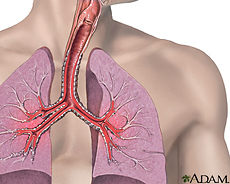Asthma is a chronic disease that affects your airways. Your airways are tubes that carry air in and out of your lungs. If you have asthma, the inside  walls of your airways become sore and swollen. That makes them very sensitive, and they may react strongly to things that you are allergic to or find irritating. When your airways react, they get narrower and your lungs get less air.
walls of your airways become sore and swollen. That makes them very sensitive, and they may react strongly to things that you are allergic to or find irritating. When your airways react, they get narrower and your lungs get less air.
Symptoms of asthma include
- Wheezing
- Coughing, especially early in the morning or at night
- Chest tightness
- Shortness of breath
Not all people who have asthma have these symptoms. Having these symptoms doesn’t always mean that you have asthma. Your doctor will diagnose asthma based on lung function tests, your medical history, and a physical exam. You may also have allergy tests.
When your asthma symptoms become worse than usual, it’s called an asthma attack. Severe asthma attacks may require emergency care, and they can be fatal.
Asthma is treated with two kinds of medicines: quick-relief medicines to stop asthma symptoms and long-term control medicines to prevent symptoms.
🌬️ What is Asthma?
Asthma is a chronic inflammatory disease of the airways that causes episodes of wheezing, shortness of breath, chest tightness, and coughing. It affects both children and adults and varies in severity from mild to life-threatening.
🔹 What Happens in Asthma?
In asthma:
- Airways become inflamed
- Bronchial muscles tighten, narrowing the airways (bronchoconstriction)
- Mucus is produced, further blocking airflow
These changes make it difficult to breathe, especially during asthma attacks.
🔹 Common Triggers
- Allergens: pollen, dust mites, pet dander
- Irritants: smoke, pollution, strong odors
- Respiratory infections: colds, flu
- Exercise: especially in cold weather
- Weather changes
- Stress or emotions
🔹 Symptoms of Asthma
- Wheezing (whistling sound when breathing)
- Shortness of breath
- Chest tightness
- Coughing (worse at night or early morning)
- Fatigue during physical activity
🔹 Types of Asthma
| Type | Description |
|---|---|
| Allergic asthma | Triggered by allergens |
| Non-allergic asthma | Triggered by cold air, exercise, stress |
| Exercise-induced bronchoconstriction (EIB) | Occurs during or after exercise |
| Occupational asthma | Caused by workplace irritants |
| Severe asthma | Persistent symptoms, requires strong treatment |
| Childhood asthma | Asthma that begins in early childhood |
💊 Asthma Medication Categories
Asthma medications fall into two main groups:
🔸 1. Quick-Relief (Rescue) Medications
Used to relieve symptoms during an asthma attack.
| Drug Class | Example Drugs | Notes |
|---|---|---|
| Short-acting beta-agonists (SABAs) | Albuterol (Ventolin, ProAir), Levalbuterol (Xopenex) | First-line rescue inhalers |
| Anticholinergics (short-acting) | Ipratropium (Atrovent) | Often used with SABAs |
| Systemic corticosteroids | Prednisone, Methylprednisolone | Short courses for severe attacks |
🔸 2. Long-Term Control (Maintenance) Medications
Used daily to prevent symptoms and reduce inflammation.
| Drug Class | Example Drugs | Notes |
|---|---|---|
| Inhaled corticosteroids (ICS) | Fluticasone (Flovent), Budesonide (Pulmicort), Beclomethasone | First-line maintenance therapy |
| Long-acting beta-agonists (LABAs) | Salmeterol, Formoterol | Must be combined with ICS |
| ICS + LABA combinations | Advair (fluticasone/salmeterol), Symbicort (budesonide/formoterol), Breo Ellipta | Popular combo inhalers |
| Leukotriene receptor antagonists | Montelukast (Singulair), Zafirlukast | Oral option, good for allergies too |
| Mast cell stabilizers | Cromolyn sodium (Intal) | Less common, mostly preventive |
| Biologics (for severe asthma) | Omalizumab (Xolair), Mepolizumab (Nucala), Benralizumab (Fasenra), Dupilumab (Dupixent) | Target specific immune pathways |
| Theophylline | Theophylline | Oral bronchodilator; rarely used due to side effects |
🔹 Inhaler Types
- Metered-dose inhalers (MDIs)
- Dry powder inhalers (DPIs)
- Nebulizers – for young children or severe attacks
- Spacer devices – help improve delivery from MDIs
🔹 Emergency Asthma Treatment
For status asthmaticus (severe, unresponsive asthma attack):
- High-dose inhaled or IV bronchodilators
- IV corticosteroids
- Oxygen therapy
- Possible mechanical ventilation
🩺 Asthma Management Tips
- Use a peak flow meter to monitor lung function
- Develop an Asthma Action Plan with your doctor
- Avoid triggers and allergens
- Use controller medications daily, even without symptoms
- Get vaccinated against flu and pneumonia
